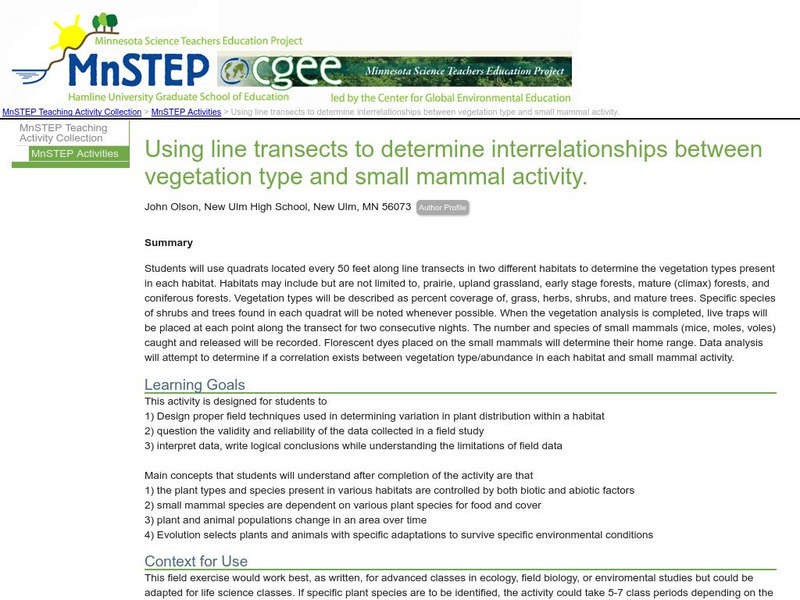Curated OER
Understanding Our Planet's Food Web
Sixth graders, in groups, examine how humans have a tenuous position as part of an ecosystem.
Curated OER
Water Quality And pH
Students determine the pH level of water and its effect on aquatic plants and brine shrimp eggs. This is a three part lesson that leads the student through the development of an understanding of water pH. They form a hypothesis and are...
Curated OER
Your Blooming Pond
Students model a pond system that becomes enriched with nutrients (fertilizer). They manipulate variables, make observations over time, and draw conclusions that may lead to further inquiry. They, in groups, simulate a pond environment.
Curated OER
Plants for Pleasure and Profit
Young scholars study about some of the specimens collected or diagrammed by Lewis and Clark, discuss their usefulness, and rank their importance. They write a persuasive essay detailing the plants they thought the most important.
Curated OER
Time For Action
Students research the major waste management facilities in their community and are encouraged to speak with public officials.
Curated OER
Lichens as Air Quality Indicators: A beginning lichen identification study (2003
Students use GPS and trees to explore lichens and air quality.
Curated OER
Growing a Garden
Students research aspects of gardening including nutrition, costs, and soil preparation. They then write a report detailing the planning of the garden and compare costs to buying the items.
Curated OER
Double Consciousness
Pupils explain the concept of double consciousness and evaluate how the concept of double consciousness is reflected in ethnic literature. They read "The Invisible Man" a poem by Langston Hughes and discuss expectations. They analyze...
Curated OER
Land Use
Students examine ecosystems that covered Illinois 200 years ago, investigate some living and non-living components of ecosystems, identify components of prairie system, create food webs, and observe human effects on environment. Lessons...
Curated OER
Using Natural Resources In Chinese And Japanese Art
Students discuss the uses and availability of natural resources in China and Japan and how those resources effected visual art from each country. This lesson includes two possible enrichment activities.
Curated OER
Listening to the Prairie
Students, in groups, visit an exhibit and for a prairie scavenger hunt to locate sunflowers and name products made from them. After sketching a prairie dog, they find nature cues farmers use when growing plants and raising animals. The...
Curated OER
Who Works in This Forest?
Students examine the variety of jobs that are related to working in the forest. Information on the different jobs is provided in this lesson plan for the teacher to share with the students. The students create a collage using magazines...
Curated OER
Gale's Curriculum
Seventh graders develop an understanding of Southeastern Asian culture. They increase knowledge of world geography in relation to Southeast Asian countries. Students research a variety of Southeast Asian animals and habitats to be used...
Curated OER
The Energy Debate - Conclusion
Pupils write a persuasive essay about the choices in the energy debate. They comprehend the environmental consequences that accompany the decision. Students predict how they will power their future.
Curated OER
Sarita Wetland Restoration
Students collaborate on the plannng and implementation of the Sarita Wetland Restoration. The Sarita Wetland is the remnant of former Lake Sarita that was drained in the early 1900's. The goal of the entire project is to improve water...
Curated OER
SHOW 303: The Channel Island Fox
Students explore how archaeologists and other scientists use different clues to piece together a picture of the past. Students perform activities that allow them to conduct three types of scientific research. They discuss their...
Curated OER
Exploring Life in the Coral Reef
Students study life forms in coral reefs. In this ocean life lesson, students study life in coral reefs as they create a coral reef sculpture.
Curated OER
School Forest Lesson- Looking at Literature
Students compare what they learned though literature to the school forest. In this environment lesson, students visit the forest surrounding their school to listen to literature and identify objects in nature. Students create a display...
Curated OER
Exploring Marine Objects
Learners identify the sources of water on Earth. In this life science lesson, students list the different plants and animals that live in the ocean. They explore marine objects in the lab and draw them.
Science Education Resource Center at Carleton College
Serc: Using Plant Surveys to Study Biodiversity
An extended field investigation intended as launch into several concepts in environmental science including biodiversity, human impacts on natural systems, and energy transfer in ecosystems.
Alabama Learning Exchange
Alex: What Kind of Plant Is It?
This lesson provides a fun way for students to learn to classify plants as vascular and nonvascular. Students will use drawing software to create pictures of vascular and nonvascular plants.
Alabama Learning Exchange
Alex: The Circles of Life
This is an inquiry based cooperative learning unit that can be used in biology as a graduation exam review or in botany for a nine week project. The learners will learn the life cycle of mosses, ferns, gymnosperms and angiosperms. The...
Huntington Library
Huntington Library: Garden Lesson Plans: Seeing Seeds [Pdf]
An exploration for younger students into the diversity of seeds and what is inside a seed. Includes extension activities.
Science Education Resource Center at Carleton College
Serc: Determining Interrelationships: Vegetation Type and Small Mammal Activity
Students design proper field techniques to determine variation in plant distribution within a habitat, and then interpret data, write logical conclusions, while understanding the limitations of field data.
Other popular searches
- Plant Diversity Activities
- Plant Diversity Map
- Genetics and Plant Diversity
- Plant Diversity Section 22.2
- Plant Diversity Section 222
- Plant Diversity Worksheet




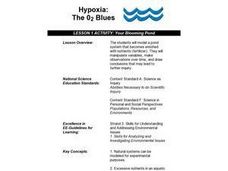






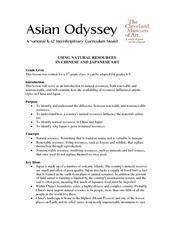





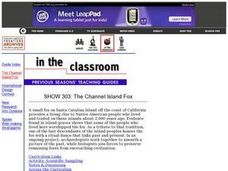


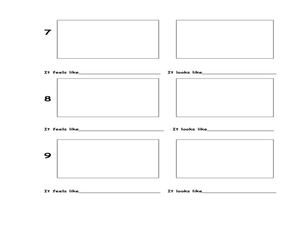



![Huntington Library: Garden Lesson Plans: Seeing Seeds [Pdf] Lesson Plan Huntington Library: Garden Lesson Plans: Seeing Seeds [Pdf] Lesson Plan](https://d15y2dacu3jp90.cloudfront.net/images/attachment_defaults/resource/large/FPO-knovation.png)
